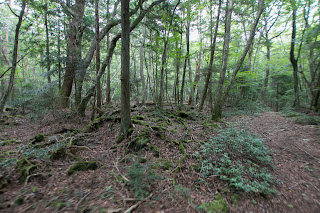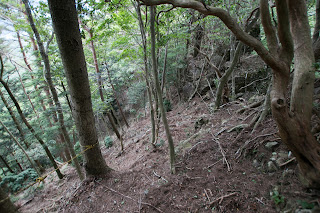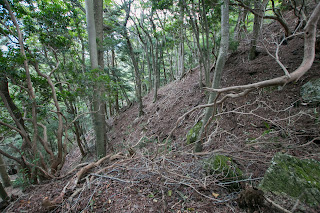Motosu Castle
-Castle built by lava stones in deep forest-
Overview
Name: Motosu castle (Motosu-jo)
Alias:
Place: Motosu Fuji-Kawaguchiko town, Yamanashi
Location: 35.47307263332677, 138.60853532463574
Type: Mountain Castle
Built: 16th century
Remaining remnants:Stone walls, clay walls and dry moats
Title:
Motosu castle (本栖城) is built over Shiroyama mountain, a ridge 100 meter height from hillside and spreads eastward from Eboshi-dake mountain at the north of Lake Motosu. Lake Motosu is one of the five lakes spreads over the north hillside of Mt. Fuji, and exist at the edge of deep forest named Aokigahara.
Aokigahara is a large deep forest of about 5 kilometer square spreads between Lake Motosu and Lake Kawaguchi. In the ancient era this area is a large flat highland area and Lake Motosu, Lake Shoji and Lake Sai were large one lake. But in 9th century because of the large explosion of Mt. Fuji, great volume of lave flew down the mountain and covered this area, and separated old lake into three small lakes.
Because of the unfertilized soil of lava produced at one time, coniferous trees rapidly spread and covered all part of the lava plain. In addition to the leafs fully covered the upward without falling, rugged surface built by lava and weaved roots of the trees, it is difficult to enter this dark forest outside from roads.
However, this area is also the shortest road between Kai province (Yamanashi prefecture) and Pacific Ocean coast area. Historically there were three major roads connected Kofu basin and Suruga province (Shizuoka prefecture), it mean Kawauchi-ji road goes along with Fuji-kawa river, Nakamichi-Oukan road passes Aokigahara forest, and Wakahiko-michi road once passed Misaka-Toge pass and runs the foot of Mt.Fuji at higher place from west to east.
Among these three roads, Kawauchi-ji road is most gentle from the view point of altitude, but it was a valley road of rapid Fuji-kawa river and there were many obstacles such as cliffs or rapid streams. On the other hand, Wakahiko-michi is a solid mountainous road but had to cross the sheer Misaka-Toge pass, and was more affected by snow in winter season.
Compared with these two roads, although Nakamichi-Oukan road had to go through two passes and deep forest, but considering its short distance and stability it was the most useful road in medieval era, before the development of river transportation at Fuji-kawa river in 17th century.
In medieval era, Takeda clan which was the governor of Kai province (Yamanashi prefecture), thought important of Nakamichi Oukan road both for offense and defense. At the beginning of 16th century, when Takeda clan confused by their internal conflicts, Imagawa clan which was the lord of Suruga province repeatedly intruded into Kai province by this road.
Later Takeda clan and Imagawa clan coordinated, and further made alliance along with Hojo clan in 1554. Under this alliance border of Kai province and Suruga province once stabilized, but it was still necessary to control the entrance and charge customs. Therefore, Takeda clan built Motosu castle and let Kuishiki-Shu, the group of small local lords, protect the castle.
Motosu castle spreads over the long and narrow ridge of Shiroyama mountain. Central area of the castle is an oblong shaped one of about 50 meter long and 15 meter wide, has front gate at its east edge and backside gate at west edge. Road to main gate climbs roundly, and stone wall basement watches this road from upward. There remains corner stones at this area, but it is not clear if they are original or placed at later period.
At the east of central area, there are long and narrow areas along the ridge. At the middle of these areas, there is a tall stone wall built at the side wall of the slope, using black lava stones. This stone wall might be built to fix the edge of the area and prevent side attack of the enemy.
Ahead of this area, combination of three dry moats securely protect the east edge of castle from the road from hillside. On the other hand, backside of the castle at westward is connected to backside mountain, then separated by deep dry moat and small fort built by rock and stones. This basement is named as a place of signal fire, but might be used as a turret to attack the enemy from backside.
At the north of central area, several terraces are built at sheer slope, utilizing stone walls to strengthen the wall. Total size of the castle is about 300 meter long and 50 meter wide, and it is a large castle compared with small number of residents. At the hillside of the mountain, line of stone walls exists on the ground here and there, and these stone walls might be the residence of soldiers or guard houses.
The alliance of Takeda clan and Imagawa clan continued about 15 years, but finally broke in 1567. At that year Takeda clan invaded into Suruga province using Nakamichi-Oukan road, and after the struggle with Hojo army still supported Imagawa clan, Takeda clan could seize Suruga province next year. The border became calm again.
However, after another 15 years, Takeda clan significantly lost its power at the defeat at the battle of Nagashino faced total attack of central ruler Nobunaga Oda (1534-1582) and his ally Ieyasu Tokugawa (1543-1616) in 1582. Ieyasu Tokugawa gained over Anayama clan which protected Suruga province intruded into Kofu basin passing this route, and Takeda clan ended its history. Also Nobunaga Oda once arrived at Kofu basin from northward returned to central area by this road.
However, just three month after that Nobunaga Oda died in the incident of Honnoji, and magistrates of Oda clan at Kai province lost their lives during the confusion. Ieyasu Tokugawa seized Motosu castle and advanced into vacant Kai province, but Hojo clan which was the lord of Sagami province (Kanagawa prefecture) also aimed at the province.
As Hojo clan captured Lake Kawaguchi area at the next of Motosu area and built Misaka castle there, Tokugawa clan had to protect Motosu area to keep their supply route. Ieyasu let Watanabe clan which was the leader of local lords protect Motosu castle, along with reinforcement army. As expected Hojo army invaded into Motosu area, but Watanabe clan drove back this attack and kept the supply route of Tokugawa clan. Stone walls of Motosu castle might be built around this time.
After half year campaign Tokugawa clan and Hojo clan coordinated then Kai province became the territory of Tokugawa clan. Motosu castle lost its significance and might be abolished soon, but gate was placed near the castle ruin continuously. During Edo era, Nakamichi-Oukan road had been used as a commercial road, especially for fishes which needed quick transportation.
Now all building was lost but structures of the castle well remain on the hill. Combination of old road in deep forest, mysterious line of stone wall at hillside and black stone walls built by lava stones at the castle is quite unique to this castle. Castle ruins quietly look down the road changed from military purpose to commercial one, and leisure one in the long time.
30 minutes drive from Chuo Jidoshado Expressway Kawaguchiko interchange .
Type: Mountain Castle
Built: 16th century
Remaining remnants:Stone walls, clay walls and dry moats
Title:
Brief History
Motosu castle (本栖城) is built over Shiroyama mountain, a ridge 100 meter height from hillside and spreads eastward from Eboshi-dake mountain at the north of Lake Motosu. Lake Motosu is one of the five lakes spreads over the north hillside of Mt. Fuji, and exist at the edge of deep forest named Aokigahara.
Aokigahara is a large deep forest of about 5 kilometer square spreads between Lake Motosu and Lake Kawaguchi. In the ancient era this area is a large flat highland area and Lake Motosu, Lake Shoji and Lake Sai were large one lake. But in 9th century because of the large explosion of Mt. Fuji, great volume of lave flew down the mountain and covered this area, and separated old lake into three small lakes.
Because of the unfertilized soil of lava produced at one time, coniferous trees rapidly spread and covered all part of the lava plain. In addition to the leafs fully covered the upward without falling, rugged surface built by lava and weaved roots of the trees, it is difficult to enter this dark forest outside from roads.
Three roads to Kai province
However, this area is also the shortest road between Kai province (Yamanashi prefecture) and Pacific Ocean coast area. Historically there were three major roads connected Kofu basin and Suruga province (Shizuoka prefecture), it mean Kawauchi-ji road goes along with Fuji-kawa river, Nakamichi-Oukan road passes Aokigahara forest, and Wakahiko-michi road once passed Misaka-Toge pass and runs the foot of Mt.Fuji at higher place from west to east.
Among these three roads, Kawauchi-ji road is most gentle from the view point of altitude, but it was a valley road of rapid Fuji-kawa river and there were many obstacles such as cliffs or rapid streams. On the other hand, Wakahiko-michi is a solid mountainous road but had to cross the sheer Misaka-Toge pass, and was more affected by snow in winter season.
Compared with these two roads, although Nakamichi-Oukan road had to go through two passes and deep forest, but considering its short distance and stability it was the most useful road in medieval era, before the development of river transportation at Fuji-kawa river in 17th century.
Build of Motosu castle
In medieval era, Takeda clan which was the governor of Kai province (Yamanashi prefecture), thought important of Nakamichi Oukan road both for offense and defense. At the beginning of 16th century, when Takeda clan confused by their internal conflicts, Imagawa clan which was the lord of Suruga province repeatedly intruded into Kai province by this road.
Later Takeda clan and Imagawa clan coordinated, and further made alliance along with Hojo clan in 1554. Under this alliance border of Kai province and Suruga province once stabilized, but it was still necessary to control the entrance and charge customs. Therefore, Takeda clan built Motosu castle and let Kuishiki-Shu, the group of small local lords, protect the castle.
Structure of Motosu castle
Motosu castle spreads over the long and narrow ridge of Shiroyama mountain. Central area of the castle is an oblong shaped one of about 50 meter long and 15 meter wide, has front gate at its east edge and backside gate at west edge. Road to main gate climbs roundly, and stone wall basement watches this road from upward. There remains corner stones at this area, but it is not clear if they are original or placed at later period.
At the east of central area, there are long and narrow areas along the ridge. At the middle of these areas, there is a tall stone wall built at the side wall of the slope, using black lava stones. This stone wall might be built to fix the edge of the area and prevent side attack of the enemy.
Ahead of this area, combination of three dry moats securely protect the east edge of castle from the road from hillside. On the other hand, backside of the castle at westward is connected to backside mountain, then separated by deep dry moat and small fort built by rock and stones. This basement is named as a place of signal fire, but might be used as a turret to attack the enemy from backside.
At the north of central area, several terraces are built at sheer slope, utilizing stone walls to strengthen the wall. Total size of the castle is about 300 meter long and 50 meter wide, and it is a large castle compared with small number of residents. At the hillside of the mountain, line of stone walls exists on the ground here and there, and these stone walls might be the residence of soldiers or guard houses.
Transition of border area
The alliance of Takeda clan and Imagawa clan continued about 15 years, but finally broke in 1567. At that year Takeda clan invaded into Suruga province using Nakamichi-Oukan road, and after the struggle with Hojo army still supported Imagawa clan, Takeda clan could seize Suruga province next year. The border became calm again.
However, after another 15 years, Takeda clan significantly lost its power at the defeat at the battle of Nagashino faced total attack of central ruler Nobunaga Oda (1534-1582) and his ally Ieyasu Tokugawa (1543-1616) in 1582. Ieyasu Tokugawa gained over Anayama clan which protected Suruga province intruded into Kofu basin passing this route, and Takeda clan ended its history. Also Nobunaga Oda once arrived at Kofu basin from northward returned to central area by this road.
However, just three month after that Nobunaga Oda died in the incident of Honnoji, and magistrates of Oda clan at Kai province lost their lives during the confusion. Ieyasu Tokugawa seized Motosu castle and advanced into vacant Kai province, but Hojo clan which was the lord of Sagami province (Kanagawa prefecture) also aimed at the province.
Usage and abolition
As Hojo clan captured Lake Kawaguchi area at the next of Motosu area and built Misaka castle there, Tokugawa clan had to protect Motosu area to keep their supply route. Ieyasu let Watanabe clan which was the leader of local lords protect Motosu castle, along with reinforcement army. As expected Hojo army invaded into Motosu area, but Watanabe clan drove back this attack and kept the supply route of Tokugawa clan. Stone walls of Motosu castle might be built around this time.
After half year campaign Tokugawa clan and Hojo clan coordinated then Kai province became the territory of Tokugawa clan. Motosu castle lost its significance and might be abolished soon, but gate was placed near the castle ruin continuously. During Edo era, Nakamichi-Oukan road had been used as a commercial road, especially for fishes which needed quick transportation.
Now all building was lost but structures of the castle well remain on the hill. Combination of old road in deep forest, mysterious line of stone wall at hillside and black stone walls built by lava stones at the castle is quite unique to this castle. Castle ruins quietly look down the road changed from military purpose to commercial one, and leisure one in the long time.
Access
30 minutes drive from Chuo Jidoshado Expressway Kawaguchiko interchange .







































































































































































































































































































No comments:
Post a Comment